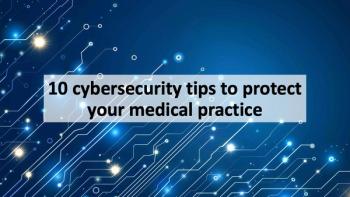
Cybersecurity: Protection amid the pandemic
Risks are evolving, here's how to keep your patients and employees safe.
In many areas of the U.S., healthcare heroes are fighting the COVID-19 pandemic on the front lines, while clinicians elsewhere are mobilizing for what still may come. Vulnerability is very real right now, and not just on the clinical side. Healthcare providers are particularly vulnerable to cyberattacks, which have increasingly
With threats on the rise due to distributed workforces and overwhelmed hospitals, it’s important to review cybersecurity best practices. By staying proactive in the face of mounting threats, physician practices can thwart hackers’ objectives and maintain the security and privacy of their patient data.
Trending:
Data protection: now, then, and always
Whether during a pandemic or operating in normal circumstances, there’s a set of basic guidelines that physician practices need to follow to protect data. First, be proactive about maintaining software by enabling automatic updates on all computers and mobile devices used for anything work-related. Anti-virus and anti-malware software need to be installed on the practice’s computers and mobile technology. Windows and MacOS do include these by default, so long as they’re enabled and up-to-date. Vulnerabilities to threats will continue to reveal themselves, so it’s important to execute the necessary security patches along the way.
Regarding data access, the safest path to maintaining security is one that requires multi-factor authentication upon login. This forces employees to demonstrate two or more pieces of evidence that confirms they are who they say they are for authentication. Finally, a solid, reliable system needs to be in place for backing up all patient data.
Pandemic-specific challenges
The rapid spread of COVID-19 has dramatically changed many industries around the world, including healthcare. For many medical practices, stay-at-home or social distancing mandates required an immediate redistribution of employees to the home setting. Many healthcare providers are also performing remote care via telemedicine visits, some for the first time. These circumstances have led to a boom in the usage of
If employees were quickly moved to work in the home setting, it’s possible security and privacy took a back seat to operations. Employees simply may not be familiar with the necessary protections required for working in a new environment. While employee utilization of virtual private networks (VPNs) to facility network resources addresses most security concerns,
Read More:
Many physicians now relying on online video conferencing tools could inadvertently give an unauthorized person the ability to enter a patient visit. The National Institute of Standards and Technology (NIST) has
If a physician’s practice is concerned about data security and privacy on mobile devices, this technology actually has some inherent advantages over desktop access. As long as sensitive patient data is only retrieved from the cloud when needed, and never stored on the device, other apps-malicious ones included-can't access it. This is often the case with mobile apps that are basically streamlined, mobile extensions of full web-based, SaaS applications and leverage many of the same APIs. When it’s necessary or useful for mobile apps to store sensitive data on the device itself, physician practices can use built-in security mechanisms provided by the mobile OS, such as KeyChain on iOS and KeyStore on Android, to enable secure storage of encryption keys and other “secrets” that can be used to securely encrypt sensitive patient data.
As healthcare continues to weather this storm, physician practices will continue reviewing their security and privacy protocols impacted by today’s unusual circumstances. By identifying weaknesses and bolstering safety strategies in response, patients and employees can remain safe despite evolving risks.
Troy Young is the chief technology officer at
Newsletter
Optimize your practice with the Physicians Practice newsletter, offering management pearls, leadership tips, and business strategies tailored for practice administrators and physicians of any specialty.














